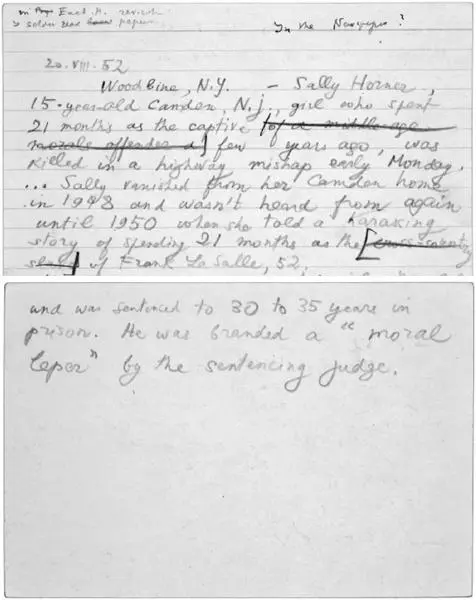The death certificate, issued by Cape May County three days later, listed the cause of Sally’s death as a fractured skull from a blow to the right side of her head. She’d broken her neck; other mortal injuries included a crushed chest and internal injuries, as well as a right leg fracture above the knee. The coroner didn’t bother with an autopsy.
The damage to her face was so severe that the state police felt Ella would be too traumatized to identify her daughter. Instead, Al Panaro went to the morgue. “The only way I knew it was Sally,” he said, “was because she had a scar on her leg. I couldn’t tell from her face.”
CAROL STARTS WAS WOKEN UP on the morning of August 18 by the sound of her mother yelling, “There’s someone on the phone for you!” There was only one phone, located in the living room. Carol got herself up and rushed out to take the call. The person on the line sounded official, like a policeman or a detective.
The caller wanted to know if Carol had been with Sally Horner the previous night.
“Yes, I was,” Carol replied.
“And you’re aware who she was with?”
“Yes I am. Why are you asking me this?”
Carol could not grasp what the caller wanted. Without waiting for an answer, she hung up the phone, then picked it up again and dialed Sally’s number. Ella answered.
“Hi, Mrs. Horner. Where’s Sally? Is she up yet?”
Ella began to sob. Then she told Carol that Sally had died in a car accident the night before.
Things grew strange for Carol. She did not react right away to the death of her best friend. She got dressed, left the house, and went straight to the movie theater. “I don’t know what I saw. I don’t know what outfit I wore. But when people wanted to talk to me, I went to the movies.” Later she understood she had gone into shock.
When Carol returned home, Ella called again. She explained in greater detail what had happened to Sally, describing the injuries she’d sustained, or at least what Ella knew of them. Only after hanging up did Carol feel the loss of her friend. “I cried and cried and cried.”
Carol also couldn’t bring herself to ask Ella about a more mundane matter. She and Sally had borrowed each other’s favorite dresses in Wildwood—and Carol’s blue frock was packed in Sally’s bag. It wouldn’t have been right to ask Ella about what happened to her dress, so Carol didn’t.
But Carol told Ella she’d met the boy who’d taken Sally on her final, fatal journey.
On the morning of August 19, 1952, as he and Véra were about to begin the long drive back to Ithaca, Vladimir Nabokov opened up a newspaper somewhere near Afton, Wyoming, and chanced upon an Associated Press story. Perhaps the newspaper Nabokov read was the New York Times, which carried the wire report of Sally Horner’s death on page twelve of their early edition. Maybe it was a local daily, which splashed the sensational news on or near the front page. Wherever Nabokov read the report, he took notes on one of his ninety-four surviving Lolita index cards.
The handwritten card reads as follows:
20.viii.52
Woodbine, N.J. –
Sally Horner, 15-year-old Camden, N.J. Girl who spent 21 months as the captive of a middle-aged morals offender a few years ago, was killed in a highway mishap early Monday… Sally vanished from her Camden home in 1948 and wasn’t heard from again until 1950 when she told a hararing [ sic ] story of spending 21 months as the cross-country slave of Frank La Salle, 52.
LaSalle [ sic ], a mechanic, was arrested in San Jose, Cal… he pleaded guilty to (two) charges of kidnaping and was sentenced to 30 to 35 years in prison. He was branded a “moral leper” by the sentencing judge.
Here, in this note card, is proof that Nabokov knew of the Sally Horner case. It is proof that her story captured his attention and that her real-life ordeal was inspiration for Dolores Haze’s fictional plight. Less clear is whether the wire report Nabokov read in August 1952 was the first time he had heard of the girl, or if he was, like all who had read the news stories in March and April 1950, stunned to realize that she’d only lived two more years after her rescue.
The note card, written on front and back, included a number of strikethroughs that ended up in the text of Lolita itself. Nabokov crossed out “middle-aged morals offender” and “cross-country slave,” both phrases that serve as Humbert Humbert’s justification to Lolita that the “bunkum” they read in the newspapers has no relation to their “father-daughter” relationship. Misspellings dotted the note card. The most notable is “harrowing,” which Nabokov tortured into some alternate, Russified version of the word.
At the top of the note card Nabokov wrote: “in Ench. H. revisited?…. in the newspaper?” As Alexander Dolinin explained, Nabokov was referring to “a scene (Chapter 26, Part II) in which Humbert revisits Briceland and in a library browses through a ‘coffin-black volume’ with old files of the local Gazette for August 1947. Humbert is looking for a printed picture of himself ‘as a younger brute’ on his ‘dark way to Lolita’s bed’ in the Enchanted Hunters hotel, and Nabokov evidently thought of making him come across a report of Sally Horner’s death in what the narrator aptly calls the ‘book of doom.’”

AP story of Sally Horner’s death transcribed onto a note card by Vladimir Nabokov.
Nabokov decided against this approach. Instead, he seeded Sally Horner’s abduction story throughout the entire Lolita narrative, making it a tantalizing thread for readers to discover on their own—though the vast majority never did.
AN ALTERNATE THEORY of the ending of Lolita pops up in Nabokovian circles from time to time. It contends that Dolores Haze, rather than meeting and marrying Dick Schiller, becoming pregnant, and then dying in childbirth before she is eighteen, actually died at the age of fourteen and a half. Her short, tragic adult life is in fact Humbert Humbert’s delusion, a projected fantasy in order to create some sort of romanticized ending for the girl he defiled.
In this version, rather than bearing responsibility for her death, Humbert can indulge in the illusion that—at least for a short time—Dolores found her way to a kind of happiness. By extension, he can remold their rapist-victim power dynamic into real love. Humbert can convince himself he did not want Dolores because she fit the nymphet type born out of his childhood obsession with Annabel Leigh, but that he pursued the girl out of some special regard for her as a human being.
If that theory is true—Nabokov certainly never confirmed or denied—Humbert’s final visit to Ramsdale carries an extra sharpness. Just before Nabokov invokes Sally Horner and Frank La Salle in a parenthetical aside, the reliable means through which he conveys true meaning to the reader, he has Humbert Humbert walking through Ramsdale, reminiscing about his first, fateful glimpse of Dolores Haze. Humbert strolls by his old house and spies a “For Sale” sign with a black velvet hair ribbon attached. Just then, “a golden-skinned, brown-haired nymphet of nine or ten” passes him, looking at him with “wild fascination in her large blue-black eyes.”
She could be a composite of Lolita and Sally, her eyes the same color as Sally’s, more or less. Humbert says, “I said something pleasant to her, meaning no harm, an old-world compliment, what nice eyes you have, but she retreated in haste and the music stopped abruptly, and a violent-looking dark man, glistening with sweat, came out and glared at me. I was on the point of identifying myself when, with a pang of dream-embarrassment, I became aware of my mud-caked dungarees, my filthy and torn sweater, my bristly chin, my bum’s bloodshot eyes.”
Читать дальше













